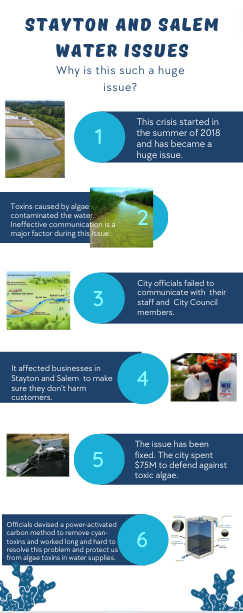Water is an essential resource that is necessary for human survival and growth. The right to access water is a topic of discussion today because of how important water is. In some cases, the water supply for a community can become contaminated. This can be extremely detrimental to all the important functions of water. Drinking contaminated water is severely dangerous and can cause numerous health issues. This is why when a community’s water becomes contaminated, it is very important for the city to take action.
The Salem and Stayton water crisis started in the summer of 2018, resulting in a public health emergency and a public relations disaster caused by ineffective communication in the city. The true cause sprouted from miscommunication, but literally, toxins caused by algae blooms in Detroit Lake contaminated Salem’s water source. Following this, city officials failed to communicate with their staff and City Council members adequately, and they did not provide adequate information to the public when the drinking water advisory was first issued.
On May 8th, an algae bloom was discovered at Detroit Reservoir, but the toxin levels were below federal and state guidelines, so the government made adjustments to fix the levels of toxins but issued no public information. A water sample was taken for the next weeks, and all came back clean until a sample was taken on May 23rd. The crisis began on May 25th when Salem Public Works staff became aware of the toxins in the water supply. However, the first drinking advisory was issued on May 29th, warning the elderly, sick, and young not to use the tap water.
The city officials quickly devised a powder-activated carbon method to remove cyanotoxins and worked long hours to solve the problem. Although the issue was spurred by miscommunication, no citizens of the towns felt the need to move because of the city’s quick solutions. The crisis was resolved, and Salem used up 75 million dollars to step up defenses against toxic algae in an attempt to avoid a repeat of the water crisis. A monitoring program has now been put in place to prevent future crises.
The water crisis most affected the vulnerable population, which included the elderly, sick, and young. These populations are more susceptible to diseases from contaminated water. The advisory warned these people to not drink the tap water, but it may have been too late after the first detection of toxins three weeks before they were warned.
Since water is an essential aspect of human life, Catholic social teaching says the lack of access to water threatens human life and human dignity. In 2010, the UN General Assembly defined water as a human right, saying that it is equal to every other human right, meaning it must be enforced. The truth of water being a human right is rooted in the ideas of common good, equal rights, and human dignity. Water is especially important to safeguard for the poor. John Paul II shared that satisfying all water needs, especially those in poverty, should guide the use of water. He continued to say that without water, life is threatened therefore, access to safe drinking water is an inalienable and universal right. Catholic social teaching also shares that humans are responsible for taking care of this earth. Genesis 2:15 says that God put man on earth to work and take care of it. With concerns about climate change, people must work to create a balance between the use of water and allowing all to access it, as well as maintaining the supply.
Water is an insanely crucial part of humans’` survival. In incidents where there are water crises, the population has every right to panic. To prevent a crisis, humans need to work to balance their use, monitoring, and sustaining of the water supply.

